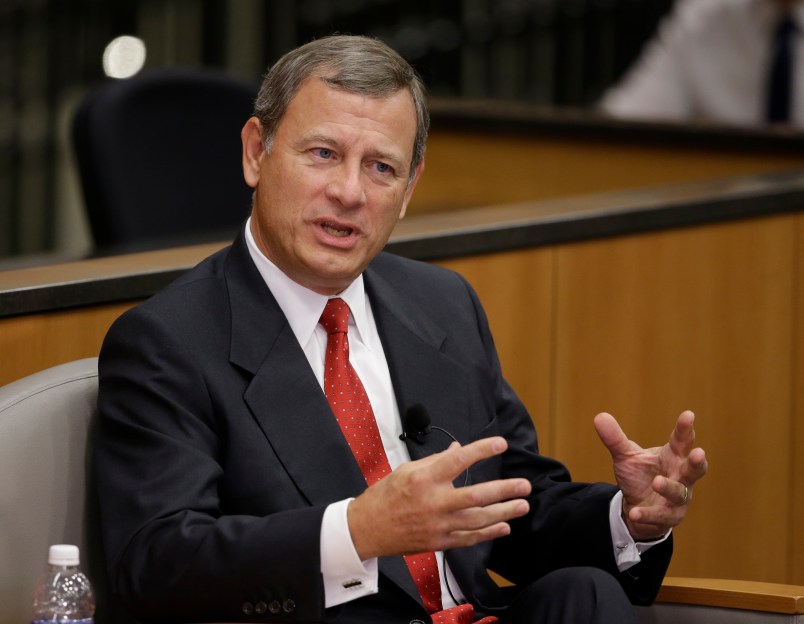As the Justice Department makes a habit out of fast-tracking to the Supreme Court the most controversial lawsuits the Trump administration is facing, perhaps there is no case where those tactics have been so extreme — and that Supreme Court has shown such a willingness to play along — than the census citizenship question case.
On Friday, the Supreme Court announced the extraordinary decision to hold a hearing on an evidentiary question in the case, just as the federal trial over the legality of the adding the citizenship question to the 2020 survey was winding down.
But that Supreme Court intervention alone wasn’t good enough for the Trump administration. By Sunday, the Justice Department had asked the trial judge, U.S. District Judge Jesse Furman in Manhattan, to delay moving forward with his post-trial proceedings, including his final judgement in the case. By Monday, before Furman even ruled on its motion, it had already taken that request to an appeals court, even as Furman had ordered briefing on the question. The Justice Department’s letter to Furman said it was prepared to ask the Supreme Court, if need be, to delay his proceedings as well.
The move shocked observers and those opposing the administration in the case, given that the Supreme Court had already denied a DOJ request to delay the trial. Nonetheless, the Justice Department pointed to the court’s willingness to review the evidence issue as a reason the post-trial proceedings should be delayed.
“Recently, the Justice Department has started acting like the normal rules don’t apply to it,” Joshua Matz, an appellate lawyer in Washington, D.C., who clerked for former Justice Anthony Kennedy, told TPM.
A spokeswoman for New York Attorney General Barbara Underwood, one of the challengers in the census lawsuit, tweeted that Justice Department showed a “lack of respect” for the judicial process.
Unreal: DOJ just filed a motion to stay our #Census2020 case w/ the 2nd Circuit — before the district court could even rule on the motion they filed yesterday. As @NewYorkStateAG Underwood has said, DOJ continues to show a remarkable lack of respect for the judicial process.
— Amy Spitalnick (@amyspitalnick) November 19, 2018
The case, a consolidation of lawsuits in New York challenging Secretary Wilbur Ross’ move to add the question, has potentially significant legal and political implications. The challengers argue that the citizenship question will cause an undercount as immigrants are discouraged from taking the survey, and that the undercount will redirect political power and resources of away from those communities. It will also further entrench the electoral advantages Republicans have in the face of a diversifying population.
The case is not the only example of the Justice Department moving aggressively to put any setbacks it suffers in a lower court in front of the Supreme Court. It also sought unsuccessfully for the Supreme Court block a trial in a climate change lawsuit, leapfrogging over an appeals court in making the request. The Justice Department tried similarly unorthodox tactics in a case over whether it can rollback protections for undocumented immigrants, known as DACA, where it asked the Supreme Court to take up the case before the lower court review was done. Likewise, in the military transgender ban case, the Justice Department has indicated it would be willing to go directly to the Supreme Court, sidestepping the appellate court.
But the census case took that already unusual strategy to the extreme. The Justice Department was at least partially rewarded for its fast-track tactics by Supreme Court Friday. The court announced that it would hear arguments in February over whether the lower court can order discovery examining Ross’ mindset when adding the citizenship question. Bafflingly, the Supreme Court’s intervention in the case came as the trial was wrapping up, but well before Furman would hand down his decision or an appeals court would have a chance to review it. It’s worth noting that a move to take up a case needs only the support of four justices; it’s unclear what the vote break down was on Friday’s grant in the census case.
The typical process — in which the Supreme Court serves as the final review of how a case was handled, rather than a referee in the midst of the game — has been turned upside down.
Georgetown Law professor Martin Lederman called the Supreme Court’s decision to grant review of the issue “very strange” and “almost inexplicable” in a blog post for law blog Balkinization.
He noted that Judge Furman has already indicated that his final decision will be organized to differentiate which parts of it are based on evidence that’s been disputed by the government and which parts are based on the portion of evidence — known as the administrative record — the administration has argued should provide the sole basis of the decision.
Lederman argued that the Supreme Court could have waited until after Furman’s decision to say if it would take up the case, and he wondered how the parties, while briefing the Supreme Court ahead of oral arguments, would react to Furman’s decision once it comes.
“I sense that I must be missing something here, but I’ve asked these questions of a bunch of people following the case, and no one’s had a clue about what the Court has in mind,” Lederman wrote.
Critics of the Justice Department’s strategy say that it undermines not just the government’s legitimacy, but the legitimacy of the entire judicial system.
“The idea that the Supreme Court is a forum of first review rather than last review is dangerous and unhealthy,” Matz said, adding that the Justice Department was forcing the court “into a minefield.”










